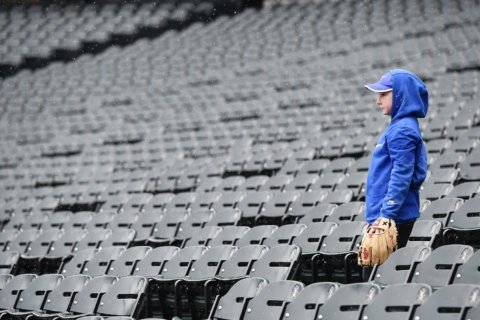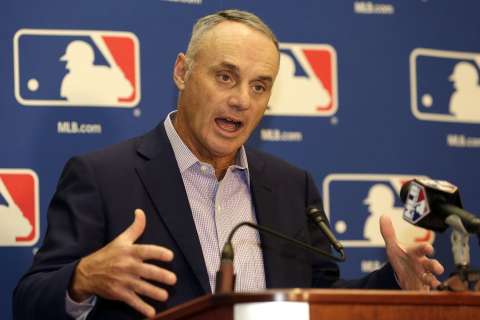WASHINGTON — Earlier this month, Washington Post sports writer Barry Svrluga posited that the drop in baseball attendance this season was directly tied to the rise in strikeouts and fall in base hits. A few days later, The Boston Globe’s Dan Shaughnessy said that “Major League Baseball is in trouble,” citing many of the same reasons. MLB Commissioner Rob Manfred has spent much of his tenure discussing tinkering with the rules of the on-field product to address the league’s declining attendance.
These are the perspectives of people who watch the game every day, for work. While they may be some of the most informed when it comes to the minutiae happening on the field, they are necessarily blind to the fan perspective, because this is their job. For those who actually pay to attend games, baseball is entertainment. And the value of such entertainment isn’t measured in pitch clocks or percentage of balls put in play — it’s measured in dollars and cents.
Simply put: Major League Baseball is too expensive.
Let’s look at the other arguments first, though. After citing the drop in league batting average to .246, the lowest since 1972, Svrluga makes the specious leap to a drop in average attendance this year. Never mind that batting average has been steady, between .251 and .255 every year since 2012, all while attendance has been slowly dropping. Never mind that home runs are well up over the last few years.
“There has to be a relationship, then, between how often hitters are able to put balls in play and how willing fans are to pay to watch them try,” Svrluga wrote.
To begin with, there absolutely does not have to be a relationship between these things. To draw a straight line between the two is what John Ameachi would call a deeply anecdotal connection, an observation of a single trend used as hard evidence to try to prove something far more complex.
Yes, MLB attendance is off this year, and it appears that the season-ticket base is eroding. But this is not a new trend. Barring a major reversal, this is the sixth straight year that MLB will draw fewer fans than the year before. Gross attendance has fallen every year since hitting 74,859,268 in 2012, and is well off the peak of 79,484,718 in 2007.
And yet, attendance at baseball games isn’t down everywhere. In fact, the minor leagues increased overall attendance 1.1 percent and average attendance 2.4 percent last year from 2016. The minors have drawn consistently (between 41.3 million and 42.6 million) throughout this period of MLB attendance decline, playing the exact same sport. It’s almost like the problem isn’t the actual sport at all.
As is true with nearly any question, within the sports world and without, the answer is a financial one. Back when the Nats played at RFK, the most expensive regular seat was about $45, the cheapest about $7. According to Statista, the average ticket this season is more than $42, double what it was in 2007. Parking, which was far less expensive at the old digs, runs $50 at Lots B and C, just beyond the outfield wall at Nats Park. Hot dogs, beer, all of it is notably more expensive. For a family of four, the full cost of attendance has basically doubled since the final year at RFK.
Meanwhile, inflation-adjusted income has remained flat for all but the highest 20 percent of earners in the U.S. over that time. In other words, plenty of people who used to be able to take themselves or their family to the ballpark simply can’t anymore.
Games are also much more accessible away from the ballpark. In the pre-regional sports network era, unless your team had a contract with a local television station, the only way to watch games from home were if they got picked up by a network broadcast, either NBC, ESPN or FOX. Even teams that did have local deals wouldn’t have them for the full 162 games — often far fewer. The broadcast availability is great, especially for those who don’t live particularly close to the ballpark or who are out of market. But it also devalues the live experience when you can stay at home and watch the game for free instead of spending a minor fortune on exorbitantly priced parking, paying for tickets and hugely inflated concessions, and managing a whole family, some of which might not be nearly as interested in the baseball as you are.
Most fans likely don’t notice the drop in hits and rise in strikeouts, because most fans aren’t watching every single pitch. Many don’t arrive to the Nationals Park until well after first pitch, and/or leave early, whether to beat traffic, put the kids to bed, or just get a jump on the foot traffic at Bluejacket or The Salt Line. They may be derided by their fellow fans for such practices, but the simple fact is that the baseball itself is not the priority for a good number of people who attend baseball games. It is an entertainment product, like anything else, and the value of the ballpark experience — which includes far more than simply the action on the field — is the most important factor in play here.
Shaughnessy laments that baseball’s stars are increasingly anonymous, which is true. Of course, the league hasn’t done itself any favors in that regard, preferring to issue cease and desist letters for everything from video rights, to shoes, to T-shirts to beer — you know, things fans actually enjoy and that endear them to the game. Oh, did I mention Manfred blamed the game’s biggest star, Mike Trout, for not marketing himself enough over All-Star Weekend?
Both Shaughnessy and Svrulga address tanking, which is an argument with a bit more merit. Yes, tanking in the standings also tanks attendance. The problem isn’t isolated to a couple teams throughout the last decade, though. Basically a full third of the league punted on free agency this year, signaling to fans no intent to compete, to put a credible product on the field. Weigh that front office apathy against the continually increasing demand of fans’ money, and it’s no stunner why people aren’t showing up for their home games.
But Svrluga is making the argument it’s why those teams won’t draw on the road. This makes no sense. Legacy teams like the Yankees, Red Sox and Cubs draw even when they’re bad, while few others ever do, even if they’re good. The die-hard transplants will still go, regardless of the state of the team. I’ve seen an A’s game in Baltimore nearly every year since I’ve been in D.C. And again — minor league attendance is up. Many times those fans have no idea who’s even playing. The tankiest team of all — the Miami Marlins — have the ninth-best road draw in the league, at better than 30,000. The Texas Rangers, with veteran stars like Adrian Beltre and Cole Hamels, are dead last, under 25,000. A lack of recognizable veteran players on visiting teams is not the problem.
Like Manfred, Svrluga’s and Shaughnessy’s microscopic analyses of the details of the game are keeping them from understanding the far more seismic forces in play. If you’re spending hours poring over minute shifts in the pace of play and trying to squeeze concrete conclusions from them, you’re missing the forest for the trees entirely. To the average fan, baseball isn’t any more or less boring than it’s always been in a way that determines their ticket-purchasing habits. But it’s a whole lot more expensive. And, increasingly, it’s just not worth the cost of attendance.






